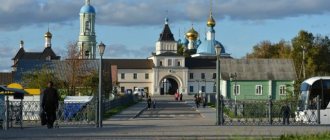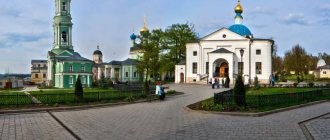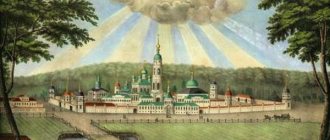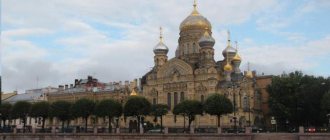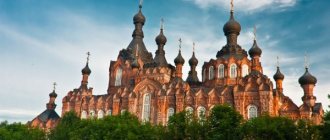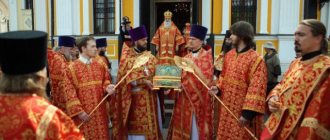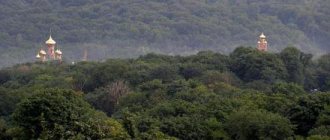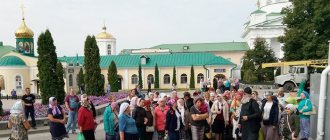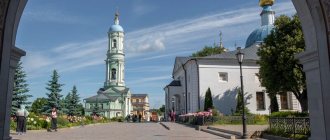History of the monastery
From the monastic chronicle it becomes clear that the institution was founded in the 15th century by a hermit named Opta.
Before accepting monasticism, he was a robber, but over time he repented of what he had done and wished to devote his life to serving the Almighty.
Bird's eye view of the monastery
Having taken monastic vows under the name Macarius, the newly minted monk began to develop the desert territory. However, another belief refutes this version, claiming that the monastery was built by the ascetics themselves, who received a sign from above. They expressed repentance for their early sins through tireless work and sincere prayers.
After construction was completed and until 1504, the monastery was inhabited by both elders and old women. However, subsequently a ban was imposed on monks and nuns living in the same territory, and the monastery turned into an exclusively male institution.
General view of the monastery
In 1689, the first stone temple appeared in the desert. In order to expand it, the Romanov dynasty assigned lands to the monastery. But under Peter I, the Optina Hermitage was abolished - due to its small number, it could not pay considerable duties. However, a similar fate then affected many monasteries.
Since 1724, new times have come for the desert - it is included in the complex of the Belevsky Spaso-Preobrazhensky Monastery. But after a couple of years, thanks to the petitions of steward Shepelev, the monastery again becomes an independent institution. However, these changes did not affect his financial well-being; he continued to exist without government funds. Of course, local boyars provided the monastery with all possible assistance, but they were not enough to maintain the monastery in excellent condition. Therefore, the wooden buildings fell into disrepair before 1764.
Holy gates of the monastery
Optina Pustyn Monastery
The meaning of Optina Pustyn
in Russian history is difficult to overestimate. The monastery is a striking example of the process of spiritual revival that arose in Russia at the end of the 18th century.
The monastery is located 4 km northeast of Kozelsk: the road crosses the Zhizdra River and runs along the monastery grove. In 1832-1839, a low fence and four corner towers were built around the monastery. 2 km from the monastery, on the same bank of the Zhizdra, is the Tupik station.
Optina elders
have always been distinguished by the highest of all gifts - the gift of prudence, as well as insight, the gift of healing and miracles. This ministry is prophetic - just as the prophets did this in apostolic times, so now the elders consoled the suffering and proclaimed the future according to the will of God.
From ancient times, the area where the cities of Kozelsk and Optina Pustyn are located was already inhabited. Thus, archaeological excavations in 1899 discovered Stone Age objects here. In historical times, it was inhabited by the Vyatichi tribes, enlightened by St. Kuksha (victims in Mtsensk in 1213). The city of Kozelsk was first mentioned in chronicles in 1146. In 1238 it was taken by the Tatars. The city bravely resisted for seven weeks. All residents were killed. According to legend, two-year-old Prince Vasily drowned in blood. The Tatars nicknamed Kozelsk “the evil city.” At the beginning of the 15th century, Kozelsk passed into the hands of Lithuania, and for half a century passed from hand to hand until it was finally established in Moscow.
History of Optina Pustyn
According to legend, the monastery was founded at the end of the 14th century by a repentant robber named Opta (Optia), or Macarius in monasticism. The Synodikon of the Optina Monastery of 1670, rewritten from the ancient synodikon, testifies that the Optina Monastery already existed in the 15th century. It served as a refuge for elders and elders who lived in two different sections under the direction of one spiritual father. The cathedral resolution of 1503 prohibited monks and nuns from living together in the same monasteries. The first written evidence of the Makaryevskaya Optina Hermitage dates back to the reign of Boris Godunov. In the Kozelsky scribe books (1629, 1630, 1631) it appears that the monastery was given “for candles and incense” to commemorate Tsar Theodore Ioannovich (d. 1598). At the end of the time of troubles, Optina Pustyn recovered from the disasters that befell it, from the Lithuanian devastation. The oldest deposit book from 1670 testifies to the contributions of the reigning persons.
It is likely that its founders were unknown hermits who chose for their exploits a remote place in the forest, far from any habitation, near the border fence with Poland, a place inconvenient for arable farming, unnecessary and not owned by anyone. Thus, Optina is one of the most ancient monasteries. It is known that in 1625 Serius was its abbot. In 1630 there was a wooden church, six cells and 12 brethren, and it was ruled by Hieromonk Theodore. Tsar Mikhail Feodorovich granted Optina a mill and land in Kozelsk for vegetable gardens. In 1689, the Shepelev brothers (local boyars) built the Vvedensky Cathedral.
In 1741, construction of a wooden bell tower began. In 1750, construction began on a new church in the name of the Presentation of the Blessed Virgin Mary, with two chapels: on the south side - the chapel of the Monk Paphnutius of Borovsky, the wonderworker, on the north - the Great Martyr Theodore Stratilates. In 1759, the temple was almost ready, and in the same year the chapel of Paphnutius Borovsky was consecrated. In 1764, by decree of Catherine II, during the secularization reform, Optina Pustyn became one of the monasteries in the Krutitsa diocese. In 1768, the construction of the new cathedral church was completed, thanks to the rich contributions of new benefactors. In 1770, according to a report, there were three monastics. In 1773, there were only two monks in the monastery - both very old men.
The position of the monastery began to change in 1795, when Metropolitan Platon of Moscow and Kaluga drew attention to the needs of the monastery. In 1796 he visited Optina Pustyn, and he really liked this place. At his insistence, Hieromonk Abraham, an experienced elder from the Pesnoshenskaya monastery, was appointed abbot of the monastery. Already in 1797, the brethren of the monastery numbered 12 people. Through the efforts of first Metropolitan of Moscow Platon (Levshin), then Bishop of Kaluga Filaret (Amphiteatrov), Optina Pustyn turned, according to Father Pavel Florensky, into “a spiritual sanatorium for many wounded souls,” which quickly attracted the attention of contemporaries.
In 1801, “for excellent services to the monastery for the common benefit,” Abraham was promoted to abbot of the Likhvinsky Pokrovsky Good Monastery, with control at the same time in Optina. But soon weakness, as well as fear that the improvement he had established in Optina would not be disrupted, forced Fr. Abrahamia refuses new dignity. The Eminence granted his request, and he was still left in charge only in Optina Pustyn, but already in the rank of abbot.
A very important milestone in the history of Optina Monastery was the coming to power of Metropolitan Philaret, who supported the establishment of eldership in the monastery. As a lover of silent desert life, he greatly patronized the desert monastery of Optina, often visiting it, sometimes living (during fasting) for whole weeks. It was he who founded in 1821 a monastery in the desert in the name of St. John the Baptist, the first “new grace” inhabitant of the desert. Filaret called there the hermits from the Roslavl forests - Moses and Anthony, as well as three other monks. These were the forefathers of Paisius Velichkovsky, who saw in eldership the most important way of reviving human souls. In 1829, eldership was introduced in Optina, with the assistance of its then rector, Fr. Moses. Optina Pustyn was the last monastery where eldership was introduced. And it was in this desert that it experienced its heyday.
This is the period of true prosperity of Optina in all respects. The material wealth of the Desert has improved significantly. By 1862, the Optina Brotherhood already extended to 150 people, including 20 hieromonks. But it was not just the external structure of the monastery and the number of brethren that Fr. Archimandrite Moses, former desert dweller of the Roslavl forests. The deanery and duration of church services, all the external and internal orders of Optina Pustyn, its entire current spiritual structure - all this was established and approved under the abbotship of Fr. Moses. With the introduction of eldership, Fr. Moses strengthened the improvement and well-being of Optina Pustyn for future times.
Optina Pustyn is famous for its care for the poor, orphans, the reception of pilgrims, its schools and hospitals. Divine services at the monastery lasted 8 hours, which, according to Fr. Sergius Chetverikov "university for the Russian people." But what distinguishes Optina from countless similar monasteries is the exceptional influence of its elders.
The eldership in the Kozelskaya Vvedenskaya Optina Hermitage was introduced later than all the eldership monasteries listed above. We know the names of probably all the elders who lived in Optina throughout its short history: Hieroschemamonk Lev (Nagolkin; +1841), Hieroschemamonk Macarius (Ivanov; +1860), Schema-Archimandrite Moses (+1862), Hieroschemamonk Ambrose (Grenkov; +1891 ), Hieromonk Joseph (Litovkin; +1911), Schema-Archimandrite Barsanuphius (Plekhankov; +1913), Hieromonk Anatoly (Zertsalov; +1894), Hieromonk Anatoly (Potapov; +1922), Hieromonk Nektary (+1928).
In our days, their feat was continued by Schema-Archimandrite Sebastian (Fomin; he died on April 19, 1966) who lived in Karaganda. In 1987, the Holy Vvedenskaya Optina Pustyn experienced its rebirth. On November 17, 1987, the surviving monastery buildings were returned to the Russian Orthodox Church, and on June 3, 1988, services began in the monastery, first in the gate church, and then in the Vvedensky Cathedral.
In 1988, the Monk Ambrose of Optina was glorified by the Local Council of the Russian Orthodox Church (celebrated on October 10 (23). In the Holy Vvedensky Optina Hermitage, the holy relics of the venerable elder were found and placed in the Vvedensky Cathedral of the monastery. On July 26-27, 1996, the remaining thirteen venerable Optina elders were canonized as locally venerated saints of Optina Hermitage, and a general Council celebration was established for them on October 11 (24). In 2000, they were glorified by the Jubilee Council of Bishops of the Russian Orthodox Church for church-wide veneration.
Every day the monastery is visited by numerous groups of pilgrims. Materials about Optina Pustyn are regularly published in church and secular periodicals. There are radio broadcasts dedicated to the monastery and its history.
The heyday of Optina Pustyn
The stage of revival of the Holy Vvedensky Monastery begins with its visit by Metropolitan Platon Levshin (the memorable visit dates back to 1796). Struck by the unprecedented beauty of this area, he set about restoring the communal sphere of the desert. At that time, the brethren of the monastery were represented by only 3 people, and not one of them was a priest.
Through the intercession of the Metropolitan of Moscow, a rector of the monastery was appointed - Hieromonk Abraham took office (the venerable elder arrived from the Pesnosha Hermitage). A year passed, and the brethren consisted of a dozen people. But the spiritual heyday of the Kozelsky stauropegic monastery came only in the 20s of the 19th century, when the Bishop of Kaluga signed a decision on its improvement.
Monastery walls
The annexation of Optina Pustyn to the Kaluga diocese only benefited it, because it received such a serious trustee as Bishop Theophylact of Kaluga. In 1809, the population of the monastery already consisted of 30 people. With the arrival of the new confessor Archimandrite Moses in the monastery, the eldership, that is, a special spiritual and guardianship activity, is revived in the desert. It is noteworthy that both members of the brethren and ordinary people who visited the hermitage could turn to the holy elders for help and advice. Thus, the once wretched institution turned into one of the significant spiritual centers located on Russian soil.
Bell tower (left), Church of the Kazan Icon of the Mother of God (center)
Every year the number of monks in the monastery increased and by the end of the 19th century reached two hundred souls. In those same years, thanks to the efforts of the Optina elders, the Kaluga land was replenished with three more monasteries, but this time for women. These are the Kazan St. Ambrose hermitage, the Dugnensky monastery “Otrada and Consolation” and the Kazan Belopopytov community.
Holy temples - components and attractions of Optina Hermitage
Architecturally, the monastery courtyard looks like a square space protected by a stone wall. The fence was erected from 1832 to 1839.
Church of the Transfiguration
Today, on the territory of the monastery and outside its aisles there are the following churches and chapels:
- The main temple, honoring the Entry into the Temple of the Most Holy Theotokos
and storing the relics of all the Optina elders and the monks Nektarios and Ambrose. - The temple in honor of the Kazan Icon of the Mother of God
is the largest of all Optina shrines. Here lie the relics of Anthony, Moses and Isaac I. The room is used for Sunday and holiday services.
Church of the Vladimir Icon of the Mother of God
- The Temple of the Vladimir Icon of the Mother of God
is a new building that appeared on the site of the destroyed shrine. The temple-tomb became a repository of the relics of the seven elders. Its consecration ceremony took place in 1998. - From the north of the Vvedensky Cathedral you can see the Church of St. Mary of Egypt
. The single-domed temple was restored in the 2000s in the best traditions of classicism. - The temple in the St. John the Baptist monastery appeared in 1825. With its construction, the craftsmen honored St. John the Baptist and the Baptist of the Lord.
From left to right: Church of Mary of Egypt and Anna the Righteous, Cathedral of the Entry of the Blessed Virgin Mary into the Temple
- Not far from the holy gates rises the small Church of the Transfiguration
, which is considered a symbol of the reviving monastery. - The temple, built in 1874 in memory of St. Hilarion the Great, stands outside the walls of the monastery.
- The temple called “The Spreader of the Loaves” was built already in 2000. You can find it on the farm plot.
- In 1993, a small wooden belfry
.
Church of St. Mary of Egypt
- In 2008, in memory of the three dead monks, the inhabitants erected a tiny chapel of the Resurrection of Christ
. - Another chapel-canopy
with a mosaic icon of the Mother of God greets tourists and pilgrims not far from the southern gate.
It is quite natural that the monastery also has its own bell tower
. It was originally built in 1802 - 1809, but due to the closure of the desert at one time its building was destroyed. Work to restore the bell tower was carried out in 1999.
Cathedrals of Optina Hermitage from above. In the foreground is the bell tower, behind it is the Vvedensky Cathedral and the Church of the Vladimir Icon of the Mother of God, to the left of the Vvedensky Cathedral is the Church of St. Mary of Egypt, on the right is the Church of the Kazan Icon of the Mother of God
Now the desert works for its intended purpose. Holidays and services are held in all churches. Both in the distant past and today, the main values of the monastery are considered to be the relics of the venerable elders, who found peace in the Kazan, Vvedenskaya and Vladimir shrines.
Bell tower of the monastery
Optina Pustyn is the favorite place of Patriarch of Moscow and All Rus' Alexy II
– the clergyman comes here quite often.
Attraction rating:
Rating 5.00 [3 Vote(s)]
| ← RUSSIA | KALUGA REGION | EUROPE → |
Optina Pustyn is the most famous monastery in the Kaluga region with a rich history. Before the revolution, Dostoevsky, Gogol, Tolstoy and hundreds of lesser-known people lived and prayed here. The Soviet government first turned the monastery into a collective farm, then into a museum, and during the Second World War into a comfortable concentration camp for Polish officers, most of whom were then shot. The destroyed monastery was returned to the church in 1987 and has since been almost completely restored. The monastery is thriving, the only dark spot in its modern history was the murder of three monks by a Satanist in 1993, those were the times then...
Local gang
Apparently, a visit from the lads from another monastery. Some sinners, or even compulsive atheists, envy the cool cars, golden crosses and full bellies of modern ministers of spirituality. I think that this is wrong, just like any envy only harms the envier. There must be goodness not only with fists (strength), but also with its attributes (cars, gold, etc.) - otherwise how to recognize where is good and where is evil. “A respectable Lord for respectable gentlemen!”
A serviceman of the Kozelsky division of the Strategic Missile Forces with his parents. Anyone who remembers anything from school history textbooks knows that Kozelsk resisted the Tatars for a long time and was destroyed by them. There is practically no physical evidence of this, but this legend is so alive that Kozelsk was given the status of “City of Military Glory”. However, although the reason was far-fetched, the status is quite real - even though the division is now seriously reduced in size (previously the missile points started from Ugra, very close to Kaluga, and ended in the very south of the region), it is intact, the missiles are still in the silos, and the division has a future - old silos are being modernized for new types of missiles. The places here are the most Russian, because according to many professional Russians, Russian people were created for war and prayer.
Tourist Oleg from soulless Moscow becomes spiritually enriched. Oleg and I went to Elbrus, where we tasted small quantities of mushrooms in Orthodoxy, so we didn’t climb to the very top, we didn’t have enough spirituality. But now we know everything.
The monastery turned out to be small. Here is the main square...
And behind there is a technical area, where the passage is closed to ordinary people.
In the center there is a cemetery... Perhaps the most cultural cemetery I have seen. No worse than in Europe.
Nanotechnology in Orthodoxy: nanochurch
Many influential people in the past are buried here. The name “Bylim” attracted attention because in Kabardino-Balkaria, on the way to Elbrus, they pass the village of Bylym.
The coolest and at the same time elegant monument on the Blessed Kaluga Land.
Crosses...
Even if a woman has a knee-length down jacket and is still wearing two pants, she will still be given a skirt. There is nothing to tempt here. But men can wear pants, even red ones. Long live the patriarchy, albeit in separate designated places.
Optina Pustyn is beautiful, but there is no antiquity. Some of the temples have been rebuilt, others have been so well restored that nothing remains of the past in them.
In ancient times, monasteries brought practical benefits - they were homes for the elderly. The monument is also new; the originals were broken by our grandparents.
Optina Pustyn
You can stay in the monastery itself, or in the cottages behind it, closer to the river...
Behavior rules.
View towards Kozelsk.
Bus schedule for Moscow. A gazelle runs to Kozelsk for 14 rubles.
Another view of Optina Pustyn
In the summer, of course, it would be more fun, but it’s a boring place for an ordinary soulless person. Nearby is the Devil's Settlement - it's much more interesting there. And Shamordino is also more interesting, especially since there is a women’s monastery there.
Snow makes you happy
Monument car from the Sosensky Mechanical Plant at the turn to Optina Pustyn. There is also a small Forest Museum from the Kozelsky forestry enterprise nearby. We headed to Kozelsk, and then to another monastery - Shamordino, where the nuns are.
Comments:
- In contact with
Social Comments
